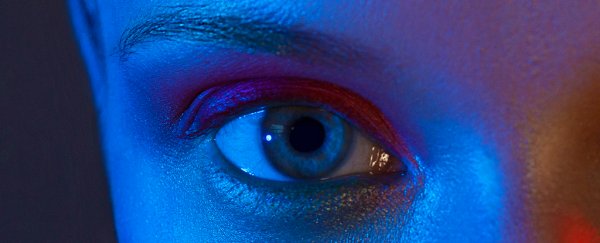Excessive exposure to blue light isn't great for our eyes, contributing to a slow loss of vision over the course of a lifetime.
Scientists from the University of Toledo in the US now understand precisely how this toxic effect works, which could be good news for anybody at risk of degenerative eye conditions.
For the rest of us, it's just one more reason to give serious thought to limiting our exposure to the cool glow of a screen long after the Sun goes down.
"It's no secret that blue light harms our vision by damaging the eye's retina," says chemist and senior researcher Ajith Karunarathne.
"Our experiments explain how this happens, and we hope this leads to therapies that slow macular degeneration, such as a new kind of eye drop."
Age related macular degeneration involves the slow breakdown of cells that sit behind the light-sensitive tissue on the inside of the eyeball, preventing the transfer of nutrients and removal of waste.
Little by little, the retina dies, leaving a growing blind spot that eventually robs an individual of their eyesight.
The condition is responsible for roughly half of all cases of visual impairment, so learning more about its triggers and influences could help a lot of people hold onto their precious eyesight for at least a few more years.
Wavelengths of light up around the blue-to-ultraviolet end of the spectrum have long been thought to aggravate macular degeneration, though the extent to which various eye diseases are caused by blue hues is still up for debate.
Karunarathne and his team focussed their attention on a chemical in the retina called retinal – a form of vitamin A that reacts to light by twisting into a different shape.
"You need a continuous supply of retinal molecules if you want to see," says Karunarathne.
"Photoreceptors are useless without retinal, which is produced in the eye."
Usually, retinal's transformation from one shape into another is reversible. Though this process isn't perfect, and in some individuals can be so inefficient it leads to a build-up of one over the other.
The researchers were familiar with reports that the twisted form of retinal – described as all-trans (ATR) – could be considered toxic in sufficient quantities.
This was blamed on a tendency for ATR to turn into something called a lipofuscin, a molecule that has the potential to damage cellular structures.
But nobody had put the pieces together to describe a likely pathway from retinal reaction to tissue degeneration.
The researchers added retinal to various cell cultures and analysed the results as they were exposed to different wavelengths of light.
It turns out lipofuscins might not be the culprit after all. Or at least, it wasn't a lone threat.
When both forms of retinal were exposed to blue wavelengths, the team found they caused a molecule in the cell's membrane to distort. This was followed by a surge in calcium that changed the cell's shape, which was ultimately responsible for its death.
The same effect wasn't found when retinal was exposed to other colours, or even when mixed as white light from a household fluorescent bulb. Blue wavelengths seemed to excite the molecule in such a way that it took on a toxic characteristic.
Crucially, this damage isn't limited to photoreceptor cells. The team tested the results on a number of tissue types (including heart cells, neurons, and cancer cells) and found they could all be affected this way.
Since retinal can move through the body, it raises concerns over just how wide-spread this toxic effect could be.
"The retinal-generated toxicity by blue light is universal," says Karunarathne.
"It can kill any cell type."
Usually we have an antidote to this kind of cell damage. A vitamin E derivative called alpha-tocopherol counters the oxidative effects.
Unfortunately, as we age, we struggle to get this chemical into the cells where it's needed most. It's not clear if therapies that raise levels of vitamin E could play a role in reducing the risks of eye disease, but further research could help identify useful links.
Meanwhile, it's one more reason for us to take a little extra care to switch off the smartphone or find a way to dim the cool hues on our monitors.
We can't avoid blue light, especially during the day. And probably wouldn't want to. It's an important cue for our body's internal clock.
But as we increasingly brighten our nights with LED technology, we're also exposing ourselves to more blue light than ever before, confusing our circadian rhythms and robbing many of us of sleep.
This isn't to say LED lighting is a bad thing. There are some important costs we might want to pay attention to, though.
This research was published in Nature.
